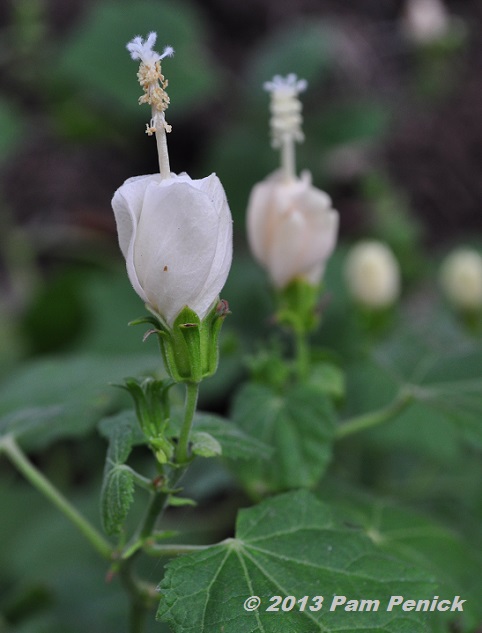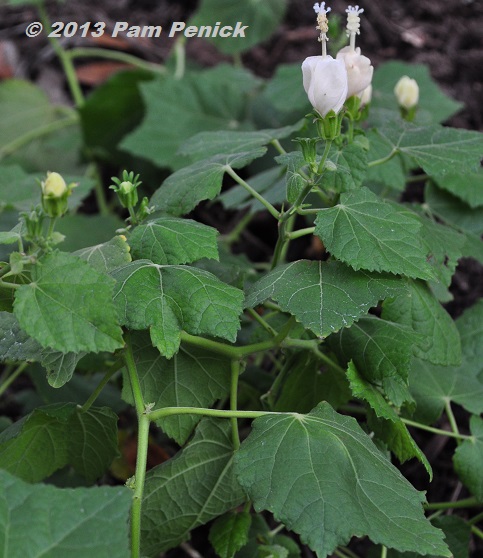Plant This: White Turk’s cap
While native Turk’s cap (Malvaviscus arboreus var. drummondii) is easily found in nurseries and growing wild along the greenbelts of central Texas, and pink cultivar ‘Pam Puryear’, a relatively new introduction, is now common in the nursery trade, white Turk’s cap can be hard to find. That’s a shame because the creamy white flowers are so cooling to the eye in the summer garden and look pretty with the plant’s large, white-veined leaves.
I grew a single white Turk’s cap in my former garden, and it was never as vigorous as the sturdy red Turk’s cap. I didn’t try to move it, and I’ve missed it since then. For a couple of years I’ve been hunting for another one at our local nurseries and even online. My searches always came up empty — until last week. While browsing at The Great Outdoors I spotted two 3-gallon containers of the ‘Alba’ Turk’s cap. Without hesitation I snapped them both up.
And even though I know I should have waited until the cooler months of October and November to plant, I went ahead and stuck them in the ground. I’ve been watering assiduously ever since, hoping to get them through the last blast of summer and into the root-growing months of fall and winter.
If you can find the white Turk’s cap, consider giving it a try. True, it won’t be as vigorous as the red or the pink ones, but its smaller size can be an asset. And although the species can handle sun or shade, I think shade is probably best for the white variety. Hummingbirds will still love it, and I know I do.
Update 1/15: Many people have asked about the white Turk’s cap since I wrote this post, and I’m sorry to say the two I bought have not thrived. One died, and I’m trying to bring the survivor back to health. At this point I wouldn’t suggest the white Turk’s cap for Austin gardeners. It seems to need a lot more shade and water than the red and pink varieties. I have heard from Laurin Lindsey of Ravenscourt Gardens in Houston that the white Turk’s cap grows very well there, which I chalk up to their higher annual rainfall; for more info read through the comments on her post, which I’ve linked to here.
Update 7/15: One of my white Turk’s cap has recovered and is growing well this summer in a shady spot. I’m hopeful it will continue to thrive.
Note: My Plant This posts are written primarily for gardeners in central Texas. The plants I recommend are ones I’ve grown myself and have direct experience with. I wish I could provide more information about how these plants might perform in other parts of the country, but gardening knowledge is local. Consider checking your local online gardening forums to see if a particular plant might work in your region.
All material © 2006-2013 by Pam Penick for Digging. Unauthorized reproduction prohibited.




I have the pink and red. Planted a ‘Big Momma’ this spring. But, I can’t tell that it’s any different than the ‘regular’ ones on each side of it. A white would be a good addition.
It has to go inside the fenced yard here. Those pesky deer will eat it….ugh
The deer have nibbled at my red Turk’s caps at times, although they usually leave them alone. I’m hoping they’ll ignore the white altogether. One of these days I need to try ‘Big Momma’. —Pam
So glad you finally found the white Turk’s Cap Pam. Mine is nearing one year in the ground and has branched out nicely the last few weeks after a slow start. It is in dappled shade.
Since you found it at The Great Outdoors I hope that means it will be more readily available.
I hope so too, Shirley. We’ll see. —Pam
Have not seen the white Turk’s Cap, will definitely have to try it! Pamie G.
PS: For other parts of the country or even your county here in Texas, the local Master Gardener’s are trained to teach you what grows local….they are a great source of knowledge for your area if you have them in your area! 🙂
Yes, good that you pointed that out, Pamela. —Pam
It’s beautiful…love the blooms…and the white-veined leaves are a nice bonus!
Cooling white for summer is just the ticket, Scott. Although I do love the red as well. 😉 —Pam
Almost missed this post – nice novelty, but the regular red and pink ones still grab me more. Maybe not enough saturated reds out here?
Maybe you just like it hot, David. So do I — in colors anyway. Red is a favorite color of mine too. —Pam
Wow, Pam! I’ve never seen the white version and am now adding it to my ‘must have’ list. I already have a large red variety (which I adore) but could certainly use a smaller, more restrained variety. And those creamy white flowers? To die for!
Rebecca, I bet it would look lovely in your garden. I missed seeing the red one when I visited this summer. Guess I need to come back for another visit! —Pam
WANT!!!!!!
Bob Beyer is going to try to propagate it from some cuttings, Katina. So maybe in future all the Austin bloggers will have one. —Pam